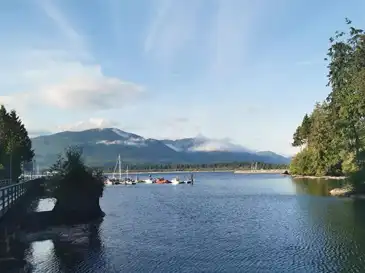Wildlife Watching Opportunities on West Coast Trail
Although West Coast Trail is quit well-known, it is a remote wilderness area where various wildlife live. Wildlife inhabiting the area stay as far as possible from humans, and it is the benefit of wildlife viewing on the West Coast Trail. So, keep in mind that if you encounter any kind of wildlife while hiking, keep a safe distance and let them be. In order to prevent further danger, please leave your food, trash, and leftovers in the garbage and do not grab their attention by any specific movements or body gestures.
Bear Watching on West Coast Trail
The West Coast Trail passes through the bear territory, with black bears being the most common. Bears hibernate during the winter and leave their dens to find food from mid-March to mid-July. There are several pairs of scats there, and you have a high chance of noticing them; this is a thrilling possibility for most tourists! Based on experiences others had during the hike, they have only spotted black bears, and in some cases, when it was wandering on the beach, they had waited for it to return to the woods. Nothing is more deadly than a mama bear with cubs, but statistics show that single males are responsible for most bear assaults. Of course, these animals can be dangerous, but in the previous 20 years, there have only been a few bear attacks reported in BC. At the campsite, place your food and waste in a bear-proof container (bear cache). You are not permitted to leave your waste there; you must take it with you at all times, since bears are highly attracted to food scent, and consequently, the bear-attack danger increases considerably.
Stay calm, speak to the bear in a calm voice, back away gently, don't run – the bear is faster than you, take out bear spray and know how to use it, and if attacked, use bear spray and fight back! We hope you have a pleasant time viewing bears while hiking.
Whale Watching on West Coast Trail
The steep West Coast Trail on Vancouver Island is known as one of the top hikes in the world for a reason. An undeniable physical challenge set against the backdrop of the gorgeous Pacific coastline and a journey with plenty of marine life viewing, whale watching in particular. Look for luminous marine life in mirror-clear tidal pools; swim beneath energizing cascades; explore an outdoor adult playground with intimidating creek ladders, suspension bridges, and self-powered cable cars. Cross huge sandy beaches under the watchful eye of bald eagles swooping overhead, looking for wolf prints or breaching whales.
Although it is called whale watching, you may encounter other underwater creatures coming up for a warm sunbathe in the middle of the day. You may lay an eye on seals, sea lions, and even dolphins if you’re lucky enough. Pay close attention, and there might be a sea otter building a wooden bridge. Nonetheless, whale species you are most likely to view are orcas and gray whales.
Whale viewing tours are available at the coastlines along the West Coast Trail. However, if you want to get as close as possible to the endless marine life of the Pacific, there might be a chance to operate our tours aboard. If you have further questions in this regard, please feel free to
contact us.
Bird Watching on West Coast Trail
Climate is what matters to birds when choosing a region to inhabit. If we want to start discussing the weather in the West Coast Trail area, we would have thought for hours to find a drawback that denies the fact that it could be one of the best places on the Island for birds, especially migratory ones, to live. Birds can be sighted every where, maybe even visible to the self-guided hikers there. However, some of them will conceal between the branches of trees or, in some cases, on the dense ground to protect their chicks from any possible threat. Then is the need for an experienced guide to show you where exactly these feathered creatures live or fly. Bird species you might spot while you’re hiking are hummingbirds and bald eagles mostly. However, you may spot some migratory birds that have built their nest for the season or reproduction.
